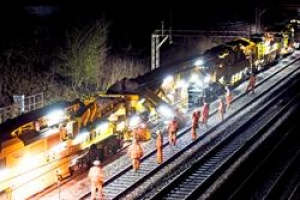Network Rail breaks track records

While records were being set at the Olympic Stadium, fastest times were also being recorded on a different sort of track.
Network Rail’s unique high output track relaying system was behind a series of record-breaking renewals, replacing old track on quieter routes not central to Olympics travel. Simultaneously, a new system to quickly replace sets of points saw a crossing at Wool in Dorset replaced over midweek nights rather than blocking a line over an entire weekend - a first in modern British railway history.
Steve Featherstone, Network Rail’s programme director of track infrastructure projects, said: “We have committed to keeping the railway open for business as much as possible, and with the intensive way it is used we have had to innovate to keep the track maintained.
“Our new method of replacing points is one way we can tackle jobs overnight midweek possessions that would once have caused the railway to be closed for a weekend.
“We have recently set new records for using these new innovative methods as we renewed a set of points at Wool overnight in 8.5 hours and our track renewal system recently relaid 968 yards in one evening.
ADVERTISEMENT
“By tackling renewals in this way we can keep the railway open longer for passengers and freight, as well as making efficiencies through better use of our people and machinery.”
The fastest track relaying system, known as system 4, consists of two trains: one to dig up the old track and relay it, the other to replace and clean the ballast. Both were designed to Network Rail’s specification to work in the restrictive loading gauge of the West Coast main line that enables us to work while keeping adjacent lines open.
In one August possession, the system replaced 1,800 yards of rail and sleepers – more than a mile – in 16 hours. The same system working on the Carlisle to Newcastle line on September 7 relaid 968 yards in just over seven hours. All five of Network Rail’s high output trains (consisting of three ballast cleaners and two track renewal systems) are operated and maintained by AmeyCOLAS.
More conventional renewal methods also set new records over the period with new records set by Balfour Beatty on the Wessex route with 1000 yards in 27 hours and 3000 yards in 50 hours.
The system of modular switches and crossings sees points built off-site and delivered on a fleet of special wagons, which tilt on their side to allow them to be transported within the loading gauge.
High output track renewal trains and tilting wagons mean that Network Rail’s equipment can be used three times more intensively, as it works as hard during the week as on weekends.
Such has been the success of track relaying this year that different routes now share their achievements to measure performance and continue to improve.
Steve Featherstone added: “Network Rail is committed to reducing costs across the railway and our new ways of working go beyond that, as by keeping lines open for longer we give operators the opportunity to exploit new opportunities.
“But of course despite the influence of the new technology, we are still dependant on the dedication and the skills of our people, who are the backbone of what we do.”
Following the Olympic period, both high-output systems moved back to the main lines into London. The high output ballast cleaners are working on the West Coast, Great Western and Midland main lines, while the track relaying systems will be seen on the West Coast at weekends and the East Coast and Midland main line midweek.

